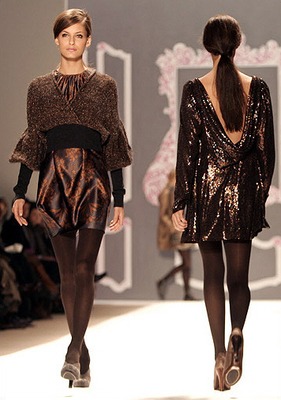Tags
Related Posts
Share This
NY fashion set defends lack of ban on skinny models…
 The leading US fashion industry body defended its decision not to issue minimum weight guidelines for models appearing at New York fashion week, despite growing calls for regulation.
The leading US fashion industry body defended its decision not to issue minimum weight guidelines for models appearing at New York fashion week, despite growing calls for regulation.
The Council of Fashion Designers of America last month issued a series of recommendations on the issue, but stopped short of bringing in strict minimum weight-to-height ratios for models as some European authorities have done.
The council’s president, designer Diane von Furstenberg, said that while the industry had a responsibility to act, regulation was not the answer.
“Since we are in the business of fashion, we create aspirational images and it’s important that we project health as a part of beauty,” Von Furstenberg said at a discussion on the issue held during New York’s fashion week.
The council’s proposals include organizing seminars on eating disorders, banning models under 16 from the catwalk and helping those in the industry identify the early signs of conditions such as anorexia.
“There should be guidelines, and no enforcement,” Von Furstenberg told the forum of nutritionists, models and fashion industry insiders. The council said last month its guidelines were “about awareness and education, not policing.”
“We never wanted to have regulations or mandatory requirements,” Steven Kolb, director of the designers’ council said earlier this month. “Regulation is not the best way to go.”
The issue has been climbing up the agenda particularly since the death of an anorexic Brazilian model late last year.
Some Italian and Spanish authorities, by contrast, have banned models with a body mass index of less than 18 — with 18.5 on the scale being the World Health Organization’s standard of a minimum healthy height to weight ratio.
Joy Bauer, a nutritionist advising the designers’ council, said looking at only body mass index oversimplified the problem.
“This issue is much more than the BMI or weight,” she said. “There are other factors, genetics and age. Some women can have a low BMI and be healthy.
“I don’t think weighing the models is realistic. It can create even more anxiety and thus more problems,” she said.
Top model Natalia Vodianova, the face of the Calvin Klein campaigns, gave a personal account of bursting onto the international fashion scene.
“In 2002 I started to do shows, and I felt the pressure from the industry. At 19… I went to a point when my weight was 106 (pounds, 48 kilos). My hair was thinning, I was nervous and oversensitive. “Luckily I was confronted by a good friend, a doctor. I was not even aware I was not healthy,” she said, welcoming the first steps towards tackling the issue in the United States.
Designer Donna Karan said the modeling agencies bore a large responsibility in taking care of their charges. “It starts at the beginning: the family and the modeling agency,” she said. “The agency is the mother of the models.”
Another designer, Tory Burch, said that any rules would be hard to enforce in the United States.
Others disagree. Lynn Grefe, head of the National Eating Disorders Association, said she was disappointed by the current suggestions.
“I don’t understand why they are opposed to physical testing,” she said. Her group earlier described the council’s measures unveiled last month as “a band-aid on a much larger wound.”
“Our concern is, who is going to monitor this program? What are the next steps? Eating disorders kill. For the sake of the models themselves and the young women who look up to them, change is vital,” it said at the time.
“The fashion industry does not cause eating disorders, but to a young girl predisposed to an eating disorder, these images are like handing them a loaded gun.”
The designers’ council insists its recommendations are just a first step, but some have other plans.
One New York City council member, Gale Brewer, has already put forward proposals that would introduce rules on the minimum age and weight of models.







